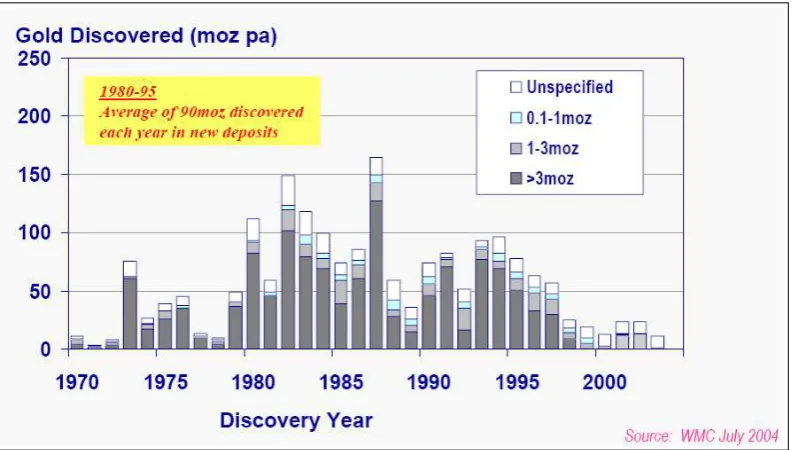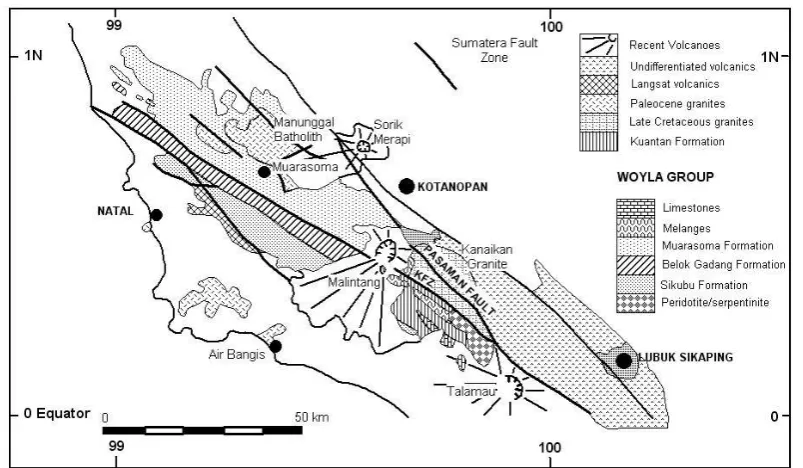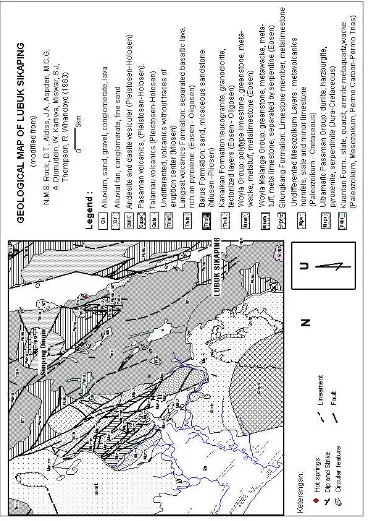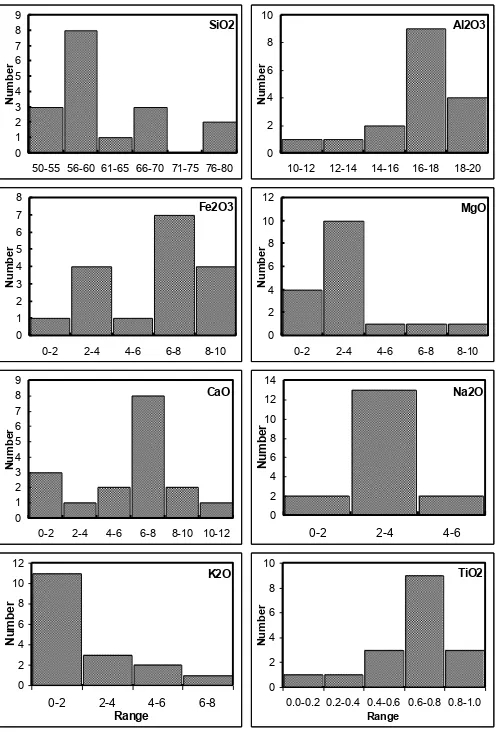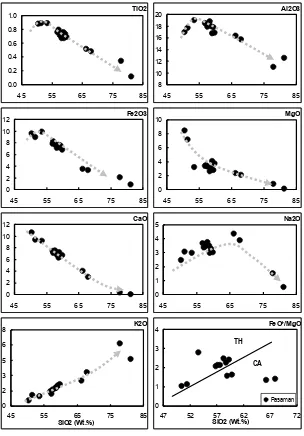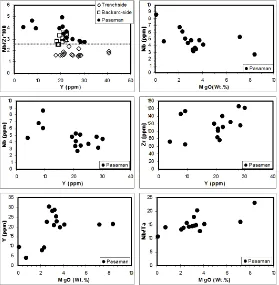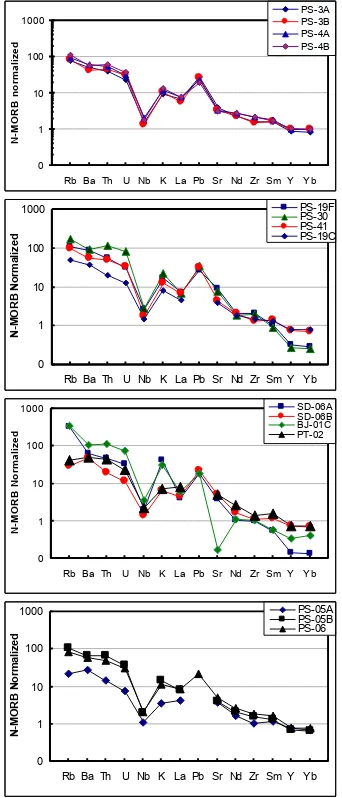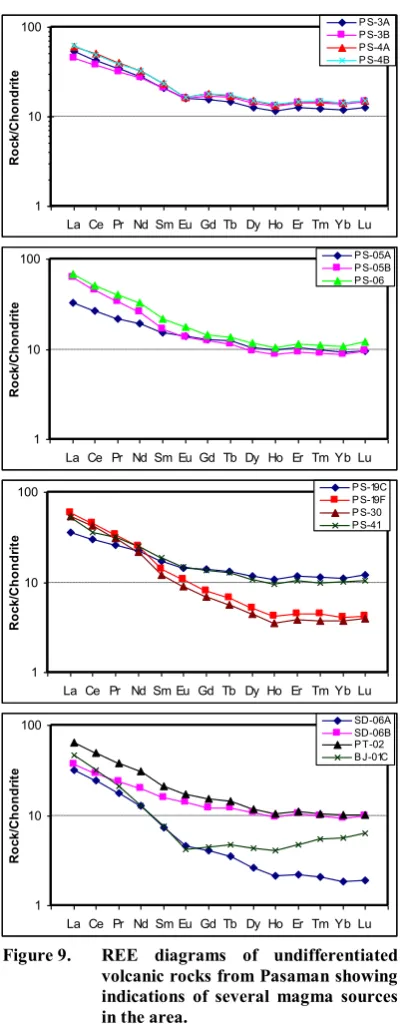RISET - Geologi dan Pertambangan Jilid 15 No.1 Tahun 2005
27
GEOCHEMICAL SIGNATURES OF VOLCANIC ROCKS RELATED TO GOLD MINERALIZATION; A CASE OF VOLCANIC ROCKS
IN PASAMAN AREA, WEST SUMATERA, INDONESIA
Iskandar Zulkarnain*, Sri Indarto*, Sudarsono* and Iwan Setiawan*
Iskandar Zulkarnain, Sri Indarto, Sudarsono and Iwan Setiawan, Geochemical Signatures of Volcanic Rocks related to Gold Mineralization; A Case of Volcanic Rocks in Pasaman Area, West Sumatera, Indonesia, RISET - Geologi dan Pertambangan Jilid 15 No.1 Tahun 2005, pp. 27 - 40, 9 figures, 1 table.
Abstract: Gold deposit is always related to volcanic activities. They occur usually in areas characterized by multi magmatic activities, indicated by occurrences various volcanic rocks with wide range composition. The source of the gold metal is believed to be magma, but not all magmatic activity related to gold mineralization. However, among different volcanic rocks in a multi magmatic activities area, only a certain magmatic or volcanic activity that related to the mineralization while the other products should be classified as barren type. It should give an important contribution for mining exploration in effort to discover new deposits in the future, if the volcanic rocks related to mineralization can be recognized easily and separated from the barren ones.
Pasaman area located in west flank of Bukit Barisan Mountain within West Sumatera Province is reported since Japanese time to nowadays having indications of gold mineralization. Small scale mining by the local people was running in Tambang Pambaluan and area near Simpang Dingin in Dua Koto Sub-District during Japanese time, but now is not active anymore. At Bonjol, in Bonjol Sub-District, local people are still doing mining activity using amalgamation method and this activity has been running for a few decades since the Dutch time. The locations are situated in a wide area that covered by so called undifferentiated volcanic rocks without any trace of its eruption center.
Major elements have been failed to separate volcanic rocks related to mineralization from the barren ones, but trace elements and REE signatures can be used effectively for the purpose. Analytical data of the rocks collected from the undifferentiated volcanic area show clear and different character of the rocks related to mineralization compared to the barren ones. The rocks related to mineralization contain Ytrium less than 10 ppm, while the barren rocks have more than 20 ppm Ytrium content. Furthermore, the rocks related to mineralization are slightly enriched on Rb. More specific character for the rocks related to mineralization is observed on REE diagrams. REE pattern of the rocks related to mineralization shows a clear and significant depletion on medium to HREE (from Gd to Lu), although the depletion can be recognized from Sm and Eu elements. The specific geochemical signatures of the rocks are interpreted to be caused by the presence of gold metal in the magma.
The aim of this paper is to demonstrate that the rocks related to mineralization have specific geochemical signatures and different from the barren rocks. The specific signatures have been found out through comparison of trace elements and REE pattern between rocks related to mineralization collected from Tambang Pambaluan, Simpang Dingin dan Bonjol with the barren rocks collected in other locations in the undifferentiated volcanic area in Pasaman.
_____________________
* Research Center for Geotechnology - LIPI
________________________
RISET - Geologi dan Pertambangan Jilid 15 No.1 Tahun 2005
28 INTRODUCTION
Gold mineralization is always interesting to be discussed, because the origin of the precious metal is still debatable. Recently, the gold metal is mostly exploited from epithermal gold mineralization and porphyry copper-gold systems; therefore its exploration is always focused to discover such deposits. Many gold mining companies run their exploration based on classical methods including geological mapping, geochemical stream sediment sampling, rock alteration analysis using PIMA and many other ways. But in fact, the success ratio for discovering new gold deposits within last decade is very small (Figure 1).
Until now, source of gold metal in the deposits is still not yet well understood. Some experts assumed that the metal is precipitated from magma, while the others believed that the gold is extracted from host rock. In this paper, the discussion is based on assumption that source of metal in gold deposits is believed to be originated from the magma.
Almost all epithermal and porphyry gold deposits are always associated with volcanic rocks. Sometimes their chemical composition shows wide range of SiO2 (from basalt to dacite)
but in other case the range can be narrower (andesite to dacite). The phenomenon indicates that the gold deposits always occurred in an area with a multi magmatic character. Unfortunately, all volcanic rocks in the area look physically and in mineralogy are very similar although sometimes there are variation in color and texture. But actually, among the volcanic products, there should be a certain product derived from a certain magmatic activity correlating to gold mineralization, while the others are un-mineralized. In other word, a gold deposit is always related to volcanic activities, but in fact, not all volcanic activities bring gold mineralization. If the character of the volcanic rocks related to gold mineralization can be recognized and separated from the barren ones, so gold exploration activities would be easier, economically lower and increasing its success ratio.
RISET - Geologi dan Pertambangan Jilid 15 No.1 Tahun 2005
29 Almost all epithermal and porphyry gold deposits are always associated with volcanic rocks. Sometimes their chemical composition shows wide range of SiO2 (from basalt to dacite)
but in other case the range can be narrower (andesite to dacite). The phenomenon indicates that the gold deposits always occurred in an area with a multi magmatic character. Unfortunately, all volcanic rocks in the area look physically and in mineralogy are very similar although sometimes there are variation in color and texture. But actually, among the volcanic products, there should be a certain product derived from a certain magmatic activity correlating to gold mineralization, while the others are un-mineralized. In other word, a gold deposit is always related to volcanic activities, but in fact, not all volcanic activities bring gold mineralization. If the character of the volcanic rocks related to gold mineralization can be recognized and separated from the barren ones, so gold exploration activities would be easier,
economically lower and increasing its success ratio.
The aim of this study is to recognize the character of volcanic rocks related to mineralization and concomitantly to get the difference between them and the barren volcanic rocks. Mineralogy based study has been failed to distinguish between them as well as major elements based study. Therefore, this discussion is focused on trace and rare earth elements.
Pasaman area is situated on central part of Sumatera island and located on west flank of Bukit Barisan Mountain. Since the Japanese time, it is reported that many gold occurrences are recognized along the west flank of Bukit Barisan Mountain striking from south to the north. It is indicated by many traces of Dutch gold mines and panning activities by local people along the area. The samples of this study were collected in small area named Tambang Pambaluan around Simpang Dingin village in Pasaman District.
Figure 2. Regional geology of Pasaman and Muarasoma areas (modified from Barber, 2000).
GEOLOGICAL SETTING
Regionally, Pasaman area is separated from Muarasoma area in the NW by recent volcanic
RISET - Geologi dan Pertambangan Jilid 15 No.1 Tahun 2005
30 Sikubu Formations that belong to Woyla Group. Beside that, there crop out also Langsat volcanic on western part of the area with structural contact. The Muarasoma Formation was intruded by Manunggal Batholith, Paleocone in age, and undifferentiated volcanic without traces of its volcanic center on the eastern part and the volcanic is bordered tectonically in the western part. Towards NW, the area is covered by the Woyla Group consisting of Kuantan Formation, melange, peridotite/serpentinite, limestone and Sikubu Formation. The undifferentiated volcanic was intruded by Kanaikan granite (Late Cretaceous in age) and the intrusion is tectonically in touch with the Woyla Group. At the south, some area is covered by recent volcanic of Talamau volcano.
In more detail (Rock et.al, 1983), the Pasaman area is arranged by rocks with age ranging from Carbon to Recent. From old to the youngest, they are Tapanuli Group containing Kuantan Formation (Early Carbon to Early Perm), Peusangan Group consisting of Silungkang and Panti Formations (Late Perm to Late Trias), Woyla Group containing mélange and Pasaman ultramafic complex (Jura to Cretaceous), undifferentiated volcanic and intrusions consisting of Ulai and Kanaikan granites (Middle to Late Miocene) and quaternary products of Malintang, Talamau and Pasaman volcanoes (Figure 3).
The Tapanuli Group is distributed randomly from south to the north and they are formed by slate, quartzite, arenite, metaquarzite, metawacke and phyllite. Peusangan Group consists of limestone member of Silungkang Formation (meta-limestone) and Panti Volcanic Formation consisting of meta-volcanic, meta-volcanic clastic and greenstones. The Woyla Group is located on the western part and consists of mélange (greenstones, meta-wackes, meta-tuff, meta-limestone, disrupted by serpentine, talc,
leucocratic dike and chert), limestone (meta-limestone, slaty (meta-limestone, calcareous slate), undifferentiated (volcanic, tuff, meta-limestone, greenschist, phyllite, slate). Pasaman Ultramafic Complex is arranged by harzburgite, dunite, pyroxenite dykes, and serpentinite in shear zones. Undifferentiated Volcanic are distributes mainly as stratiform volcanic without any traces to their volcanic center. Their composition ranges from basaltic to acidic in both matrix and their fragments. Ulai intrusion shows no influences of tectonic and it consists of granodiorite, pegmatite granite and biotite granite, while the Kanaikan intrusion is tectonically controlled and consists of leucogranite and granodiorite. Quaternary volcanic is distinguished into Malintang Center, Talamau and Pasaman Centers. They are dominated by lava and small amount breccias with porphyritic texture and their composition varies from basalt to andesite.
METHODOLOGY
As mentioned before, the main point of this research is to find the specific or unix character of volcanic rock that related to gold mineralization and use it to distinguish between volcanic rocks bearing mineralization and the barren one. Mineralogy based study is failed to distinguish both volcanic rocks and therefore in this study, the chemical parameter is chosen. Among the elements that can be obtained from chemical analyses, trace elements and REE are used for discussion while the major elements are used just for demonstration of rock variation.
RISET - Geologi dan Pertambangan Jilid 15 No.1 Tahun 2005
31
F
ig
ure
3
.
Geo
lo
g
ica
l
m
a
p
o
f
Lubuk
Si
ka
pi
n
g
tha
t
co
v
ers
P
a
sa
m
a
n
a
re
a
(a
fter
R
o
ck
et.
a
l.
,
1
9
8
3
).
RISET - Geologi dan Pertambangan Jilid 15 No.1 Tahun 2005
32 SAMPLING LOCATION
In the north,the samples were collected in the area of undifferentiated volcanic rocks located along Sinabuan river, at Tambang Pambaluan and near Simpang Dingin village (Figure 4), while in the south they were sampled on a river at Pinagar village (03, 04, 05 and PS-06) and at foot of Talamau volcano (PS-01 and PS-02). The samples from the last location do not belong to undifferentiated volcanic rocks anymore. There are other samples from undifferentiated volcanic area that were collected along the road from Bukittinggi to Panti via Lubuk Sikaping. They were sampled near Petok village (PT-01, PT-02) and around Bonjol city (BJ-01).
The samples collected around Tambang Pambaluan (from location PS-19, PS-30), near Simpang Dingin village (location SD-06) and Bonjol (location BJ-01) are related to mineralization, due to occurrences of gold vein system in the areas, while the other samples are classified as un-mineralized volcanic rocks. The samples at location PS-01 and PS-02 are quaternary volcanic products of Talamau volcano, while the other samples belong to undifferentiated volcanic rocks that Miocene in age. The gold vein system at Tambang Pambaluan is indicated by occurrence of 7m wide quartz vein in slate as host rock, while quartz vein in Bonjol area is found in volcanic host rock.
33
R
IS
E
T
–
G
eo
lo
g
i d
a
n
P
er
ta
m
b
a
n
g
a
n
Ji
lid
1
5
No
.1
Ta
h
u
n
2
0
0
5
Table 1. Chemical analysis of volcanic rocks from Pasaman area.
Major element (in %wt.)
PS-3A PS-3B PS-4A PS-4B PS-05A PS-05B PS-06 PS-19C PS-19F PS-30 PS-41 SD-06A SD-06B PT-02 BJ-01C
SiO2 56.73 56.79 57.91 58.68 50.24 59.59 57.54 56.85 65.60 67.51 58.25 76.45 52.28 51.23 78.35
Al2O3 18.36 17.54 17.71 17.55 16.81 16.70 18.54 18.22 16.13 15.63 16.55 10.72 18.52 17.55 12.11
Fe2O3 7.73 7.58 7.50 7.35 9.46 6.74 6.94 8.15 3.40 3.27 7.05 2.02 9.62 8.92 0.80
MnO 0.139 0.148 0.142 0.135 0.177 0.131 0.160 0.157 0.071 0.043 0.127 0.030 0.313 0.162 0.013
MgO 3.36 3.20 3.00 2.74 8.37 3.71 2.53 3.43 2.27 2.09 4.03 0.73 3.10 7.14 0.11
CaO 7.38 7.42 6.17 6.34 10.51 6.64 6.67 7.07 4.00 2.97 7.12 0.27 8.86 9.31 0.03
Na2O 3.64 3.34 3.43 3.22 2.44 3.02 3.70 3.35 4.29 3.86 2.93 1.46 2.88 3.04 0.50
K2O 1.40 1.57 1.72 1.96 0.52 2.09 1.67 1.17 2.47 3.29 1.84 6.01 0.92 1.04 4.44
TiO2 0.76 0.70 0.74 0.72 0.87 0.69 0.66 0.79 0.51 0.48 0.67 0.33 0.87 0.88 0.11
P2O5 0.19 0.16 0.18 0.14 0.14 0.17 0.26 0.17 0.18 0.16 0.14 0.11 0.16 0.24 0.02
LOI 0.55 0.79 1.68 0.62 0.56 0.70 1.05 1.00 0.66 0.98 1.39 1.83 2.88 0.51 3.47
Total 100.22 99.24 100.20 99.45 100.09 100.15 99.71 100.34 99.56 100.28 100.08 99.95 100.39 100.04 99.96
Trace and Rare Earth Elements (in ppm)
V 163 145 140 147 234 137 95 158 62 59 158 27 210 191 7
Cr -20 -20 -20 -20 288 50 -20 -20 49 48 108 33 34 194 -20
Co 16 14 15 14 36 15 11 16 10 9 18 9 23 26 4
Ni -20 -20 -20 -20 103 -20 -20 -20 36 39 22 23 -20 75 -20
Cu 23 22 19 21 52 26 17 15 -10 18 32 -10 23 46 -10
Zn 85 76 95 77 69 70 83 109 43 44 89 40 99 71 -30
Ga 18 16 18 18 16 16 18 18 17 17 16 7 18 17 12
Ge 2 2 1 2 2 1 2 2 1 1 2 -1 2 1 2
As -5 -5 -5 -5 -5 -5 -5 -5 -5 -5 -5 17 -5 -5 -5
Rb 43 47 52 65 13 60 48 28 62 97 54 184 16 24 199
Sr 366 311 307 292 349 356 466 358 804 682 392 351 454 463 15
Y 25 29 28 30 21 19 22 23 9 8 21 4 21 21 9
R
IS
E
T
–
G
eo
lo
g
i d
a
n
P
er
ta
m
b
a
n
g
a
n
Ji
lid
1
5
No
.1
Ta
h
u
n
2
0
0
5
34
Table 1. Chemical analysis of volcanic rocks from Pasaman area (continued)
Nb 4 3 5 4 3 5 5 3 6 7 4 5 3 5 8
Mo -2 -2 -2 -2 -2 -2 -2 -2 -2 -2 -2 -2 -2 -2 -2
Ag -0.5 -0.5 -0.5 -0.5 -0.5 -0.5 -0.5 -0.5 -0.5 -0.5 -0.5 -0.5 -0.5 -0.5 -0.5
In -0.2 -0.2 -0.2 -0.2 -0.2 -0.2 -0.2 -0.2 -0.2 -0.2 -0.2 -0.2 -0.2 -0.2 -0.2
Sn -1 1 1 1 -1 -1 1 -1 -1 -1 -1 -1 -1 -1 3
Sb -0.5 -0.5 -0.5 -0.5 -0.5 -0.5 -0.5 -0.5 -0.5 -0.5 -0.5 0.6 -0.5 -0.5 -0.5
Cs 1.7 3.2 3.0 2.3 0.8 1.8 1.7 1.5 1.1 5.5 2.0 1.6 2.8 1.0 4.7
Ba 321 263 400 372 172 422 380 244 543 580 349 392 291 310 662
La 17.2 14.4 19.5 19.6 10.4 20.2 21.6 11.5 18.7 17.2 16.9 10.3 11.6 20.4 14.9
Ce 35.3 30.6 41.5 40.2 21.7 37.0 41.9 24.8 37.0 35.1 29.6 20.3 23.8 40.5 26.0
Pr 4.17 3.78 4.87 4.77 2.66 4.05 4.85 3.10 4.05 3.75 3.80 2.14 2.87 4.65 2.53
Nd 17.5 17.0 20.1 20.1 12.0 15.8 19.9 13.7 15.6 13.6 15.7 7.8 12.4 19.2 8.0
Sm 4.2 4.2 4.8 4.7 3.1 3.4 4.3 3.5 2.8 2.4 3.8 1.5 3.2 4.2 1.5
Eu 1.24 1.21 1.28 1.24 1.08 1.03 1.34 1.09 0.83 0.70 1.13 0.35 1.06 1.32 0.32
Gd 4.1 4.5 4.7 4.8 3.4 3.3 3.9 3.7 2.2 1.8 3.6 1.1 3.3 4.1 1.2
Tb 0.7 0.8 0.8 0.9 0.6 0.6 0.7 0.7 0.3 0.3 0.6 0.2 0.6 0.7 0.2
Dy 4.2 4.7 4.9 5.0 3.5 3.1 3.8 3.9 1.7 1.5 3.6 0.9 3.5 3.9 1.5
Ho 0.9 1.0 1.0 1.0 0.8 0.7 0.8 0.8 0.3 0.3 0.7 0.2 0.7 0.8 0.3
Er 2.8 3.1 3.2 3.2 2.2 2.0 2.5 2.5 1.0 0.8 2.3 0.5 2.2 2.4 1.0
Tm 0.41 0.47 0.48 0.50 0.33 0.30 0.37 0.38 0.14 0.12 0.33 0.07 0.33 0.35 0.18
Yb 2.6 3.0 3.1 3.1 2.1 2.0 2.4 2.4 0.9 0.8 2.2 0.4 2.1 2.2 1.2
Lu 0.42 0.48 0.50 0.50 0.32 0.32 0.40 0.40 0.14 0.13 0.35 0.06 0.32 0.34 0.21
Hf 3.5 3.5 4.7 4.5 2.1 3.3 3.7 3.0 4.1 3.9 2.9 2.1 2.3 3.0 2.4
Ta 0.2 0.2 0.3 0.3 0.1 0.4 0.3 0.2 0.4 0.5 0.3 0.3 0.2 0.3 0.8
W -1 -1 12 -1 -1 -1 -1 -1 -1 -1 -1 -1 -1 -1 -1
Tl 0.3 0.4 0.4 0.4 -0.1 0.4 0.3 0.3 0.4 0.7 0.4 3.4 0.3 0.2 2.4
Pb 8 8 7 6 -5 -5 7 -5 8 11 10 6 6 -5 5
Bi -0.4 -0.4 -0.4 -0.4 -0.4 -0.4 -0.4 -0.4 -0.4 0.5 -0.4 -0.4 -0.4 -0.4 0.4
Th 4.7 5.5 6.5 7.2 1.7 8.0 6.1 2.5 6.8 13.9 6.0 5.6 2.3 5.3 14.0
RISET – Geologi dan Pertambangan Jilid 15 No.1 Tahun 2005
35 ROCK CHEMISTRY
15 (fifteen) samples of volcanic rock from Pasaman area were analyzed chemically for major, trace and rare earth elements. The chemical data is given in Table 1. Most of the rocks can be classified as fresh rocks indicated by low Lost on Ignition (LoI) ranging from 0.5 to 1.80 wt%. There are 2 other samples that probably already influenced by alteration processes reflected by higher LoI values varying from 2.88 to 3.47 wt%. This condition will be considered in discussion.
Major Elements
Most analyzed rocks belong to un-differentiated volcanic rock without any trace of its eruption center, but there are some samples from the Kanaikan granite. They range in composition from basalt through andesite to dacite with SiO2 varying from 50 wt% to 67 wt%. The granite shows SiO2 content between 76 to 78 wt%. The undifferentiated volcanic rocks in Pasaman area are dominated by basaltic andesite with relatively higher on Al2O3 content ranging from 16 to 18wt% (Figure 5). They are rich on iron and contain low magnesium as well as higher on sodium and low on potassium.
Figure 5. Histogram of major elements of the undifferentiated volcanic rocks from Pasaman area. SiO2
50-55 56-60 61-65 66-70 71-75 76-80
N
10-12 12-14 14-16 16-18 18-20
N
0.0-0.2 0.2-0.4 0.4-0.6 0.6-0.8 0.8-1.0
RISET – Geologi dan Pertambangan Jilid 15 No.1 Tahun 2005
36 To get a picture of genetic relation among the rock samples, they are plotted in Harker diagram after normalization of the analytical data. They show a relatively clear differentiation trend from basalt to dacite, while the granite should be believed to be derived from different source. The trend can be recognized in all oxides, even in alkali elements that usually show scattered
distribution. The fractionation was begun from basaltic rocks containing similar TiO2 content
RISET – Geologi dan Pertambangan Jilid 15 No.1 Tahun 2005
37 Magnesium shows a steep decreasing trend from basalt to andesite indicating formation of Mg-rich mafic minerals, and it is in line with very small consumption of iron. Very low Mg-content of the sample located below the fractionation trend is caused by the alteration process indicated by its high LoI. It looks like that significant amount of magnesium was removed from the rock and accompanied by introducing aluminum into the rock.
Generally, the fractionation trend reflects that the undifferentiated volcanic rocks from Pasaman likely were differentiated from basalt to dacite in a good trend line. The trend can be recognized in all oxide diagrams. But, plotting the samples on classification diagram SiO2 vs
FeO*/MgO show not all of the rocks belong to tholeiit type where the granite and two andesites are classified as calc-alkaline type.
In account to find out the different character between volcanic rocks related to mineralization
and the barren volcanic rocks, in fact, the major elements have been failed. No distinction can be recognized among the rocks in Harker diagrams.
Trace Elements
Not like major elements, trace elements occur in small abundant in the rocks and usually they are more sensitive than the major elements. Some elements are very sensitive to their environment so that their abundant can be used as indicator for their origin or tectonic origin. Many of them can be classified as immobile elements but some of them can be influenced by secondary processes (e.q. abundant of Ba and Rb can increase through breakdown of plagioclase).
Based on the trace elements properties, the samples were plotted in correlation diagram as below (Figure 7). MgO and Ytrium (Y) are selected for sensitive elements plotted along abscise because their abundant changes easily with changing of chemical condition.
RISET – Geologi dan Pertambangan Jilid 15 No.1 Tahun 2005 mineralization, because the samples from mineralized area are distributed in the same group with those from un-mineralized one. In the diagrams using Y as parameter, the samples are distinguished clearly into two different groups where the first group has Y content less than 10 ppm, while the second group contains Y more than 20 ppm. Furthermore, four samples belonging to the first group are the samples related to mineralization, while others in the second group, including the granite, are volcanic rocks that un-related to mineralization. Plotting the Pasaman samples in classification diagram Y vs Nb/Zr*100 (Zulkarnain, 2001) shows that all Pasaman samples belong to “back arc” volcanic type.
Plotting the samples in spider diagrams is in line with the above result, where the Y-content of volcanic rocks related to mineralization show anomaly negative in normalized to N-MORB (Figure 8).
The spider diagrams show that all samples are depleted on Nb with Rb values, in N-MORB normalized, around 100 and the values of Y and Yb around 1, except the samples related to mineralization having Y and Yb contents less than 1. For the volcanic rocks related to mineralization, the values of Rb tend to be higher than barren rocks (higher than 100). The also not really similar, even one sample of them (BJ-01C) is depleted on Sr (out of the pattern) while the sample SD-06A is very low on Y and Yb.
Rare Earth Elements
The trace elements are used successfully to separate volcanic rocks related to mineralization
Figure 8. Spider diagrams of undifferentiated volcanic rocks from Pasaman showing anomaly negative of Y for rocks related to mineralization.
from those of barren type, but the rocks related to mineralization have not exactly similar pattern in spider diagrams. The different of the pattern could be caused by the different of magma source, or in other word, they did not come from same magma chamber. For revealing the genetic relation of the rocks, REE will be used as parameters.
RISET – Geologi dan Pertambangan Jilid 15 No.1 Tahun 2005
39 to chondrite and they are plotted together in diagrams below (Figure 9).
Figure 9. REE diagrams of undifferentiated volcanic rocks from Pasaman showing indications of several magma sources in the area. 06) and it is interpreted to be derived from same magma source, while the other one (PS-05A) is believed to be originated from different magma source. Both diagrams contain no volcanic rocks related to mineralization.
The third and fourth diagrams contain rocks related to mineralization, namely samples PS-19C, PS-30, SD-05A and BJ-01C. On both diagrams, it is clearly recognized the different pattern of the rocks related to mineralization where they are depleted on many elements (from Sm to Lu). Although they show depletion on those elements, but the pattern could be quiet different. Generally, the depletion occurs from Gd to Lu, while for Sm and Eu they do not volcanic rocks related to mineralization are not derived from same magma source because they show completely different pattern.
Based on the REE pattern, it can be interpreted that at least there are five magma sources for undifferentiated volcanic rocks in Pasaman area, where the rocks related to mineralization probably came from 3 different magma sources while the rocks of barren type probably were derived from two different magma chambers.
CONCLUSION
Volcanic rocks related to mineralization have specific character and can be distinguished from the barren ones. The character can be recognized
RISET – Geologi dan Pertambangan Jilid 15 No.1 Tahun 2005
40 through trace and rare earth elements. The volcanic rocks related to mineralization contain Ytrium less than 10 ppm, while the barren ones have more than 20 ppm Ytrium content. This phenomenon can be observed also in spider diagrams of the trace elements. Furthermore, the spider diagrams show also slightly enrichment of Rb in the rocks related to mineralization than the barren ones. The specific character of the rocks can be also observed in pattern of their REE diagrams. The rocks related to mineralization are depleted significantly on medium to Heavy Rare Earth Elements (HREE). The clear depletion can be followed from Gd to Lu, although the depletion has begun from Sm and Eu. The pattern of depletion can be different from one rock to another rocks and it depends on the character of their magma sources.
In case of Pasaman area, the volcanic rocks were sampled from undifferentiated volcanic rocks without any trace of their eruption centers. The rocks show a wide range of composition, from basalt to dacite. It indicates that the area was influenced by multi magmatic activities as well as worldwide areas containing metal deposit within. Tambang Pambaluan and Bonjol are two locations that are reported since Japanese time to
nowadays having indications of gold
mineralization. Therefore, the rocks from these locations can be used as samples related to mineralization and compared to other rocks that classified as barren type. The specific character of rocks related to mineralization should not depend on the rock type or on SiO2 content,
because the character can be only observed on trace elements and REE signatures. This study gives the evident that the Tambang Pambaluan
rocks, dacitic in composition show similar geochemical signatures with the Bonjol rocks having granitic composition. They show a clear and significant depletion on HREE compared to volcanic rocks of barren type. The REE diagrams reflect also that the barren volcanic rocks of undifferentiated volcanic rocks in Pasaman area are derived from two different magma sources, Mesozoic evolution of the Sundaland
margin, Jour. Asian Earth Sciences,
vol.18, 713-738
Rock, et.al, 1983, Geological Map of the Lubuk
Sikaping Quadrangle, Sumatera, Geol.
Research Dev. Center, Bandung
Indonesia.
Schodde, R., 2004, Discovery Performanceof the Western World Gold Industry1985-2003, Pacrim Congress, Adelaide,
(http://www.wmc.com/acrobat/pacrim200 40922.pdf)
Taylor, St.R. and McLennan, SM, 1985, The Continental Crust: its Composition and
Evolution, Blackwell Scientific
Publications. Geoscience texts.
Zulkarnain, I., 2001, Rock chemistry of quaternary volcanics around Manado and
Siau island, North Sulawesi, Jurnal JTM,
